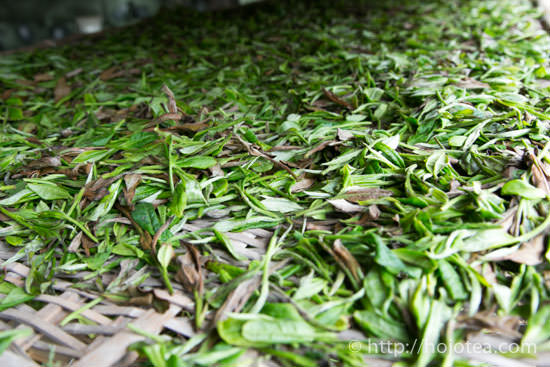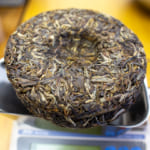- HOME >
- Tea Processing
The secret of making quality white tea
- [2013.03.30] Posted By Akira Hojo
I have spent two days in the white tea factory located in Fuding city of Fujian province in China.
The difference between white tea and green tea
The main difference of white tea from green tea is that green tea will undergo either pan-frying process or steam-heating process in order to inactivate the enzyme. As for white tea, there is no heating process to inactive the enzyme. If fresh tealeaf is heated, we do not call it white tea, but green tea. There are many kinds of green tea in the market that appearance is very white thanks to the white pekoe. But they are still called green tea as long as heating process is involved.
The withering is the simplest and the most difficult process
The most important process for making white tea is the withering process. It involves outdoor withering under the sun and indoor withering at controlled room temperature. After the fresh tealeaves are plucked and gathered, it will be sent to the factory. The fresh tealeaves are then carefully spread on the bamboo plate and left under the sun for a few hours, and subsequently it will be kept in a room for more than 12 hours. The room is equipped with fans to circulate the air. Besides, the room is kept warm using hot air. Usually, the room temperature is controlled at about 36 degree C. Many people tend to think that making white tea is very easy since it just has to be naturally dried. If one never care about the tea quality, it is indeed very easy to produce. You just need to keep tea in a room with good ventilation so that tea will lose moisture and becomes white tea. However, the simply dehydrated tea will develop stale or oxidized flavour. The leaf sometimes turns brown if excess fermentation occurs. Besides, without much attention during the handling of teas, it becomes red once tealeaf is damaged, or if it’s stack, it turns black.
Managing moisture is the key
We followed master Zhen who has more than 40 years of experience in making white tea. According to him, the key to process good white tea is the speed, management of right temperature and duration of withering process. If tealeaf is half-way dried, the moisture distribution between the surface of leaf and inside the leaf is not the same. If one just continues the same temperature, the moisture will be trapped inside the leaf and it will develop stale flavour. When the moisture on the surface starts disappearing, they have to raise the room temperature in order to reduce the internal moisture.

Fresh tea leaves meant to be processed into Bai Mu Dan
The freshly processed Bai Mu Dan

The withering process of silver needle
Indoor withering of Bai Mu Dan
White tea is supposed to give floral flavor
With the good management in process, the white tea will develop sweet and floral flavour. It is very refreshing and you can hardly feel any stale flavour. After spending two days in Fuding, I managed to find the right manufacturer and successfully purchase two types of white tea. For the details about the white teas, I will continue later.
Related Articles
How to get the latest update on HOJO?
1. Follow Twitter, 2. Click "Like" on Facebook, and 3. Subscribe in newsletter. You can have the latest tea news from HOJO.
 Subscribe the Newsletter to enjoy the privileges
Subscribe the Newsletter to enjoy the privileges- You may receive a free sample upon purchase, or you may have the priority to purchase special products. So please remember to subscribe our newsletter as well as the social network.
- New Arrival of Akitsu Mumyoi and Nosaka Rough Clay Teapot
- A wide selection of teaware by Watanabe Tozo, a Sado-based artist of Mumyoi-yaki, has just arrived. This time, …
- Mang Fei Ripe Pu-erh Tea 2023 – Small-Batch Production from a Renowned Region
- Mang Fei Ripe Pu-erh Tea 2023 is now available. This is one of the highest-quality ripe pu-erh teas among our …
NEW ARTICLES
 Development of Firewood Roasted Hojicha Using Naturally Grown Tea from Yunnan
Development of Firewood Roasted Hojicha Using Naturally Grown Tea from Yunnan- We are currently staying in Yunnan Province for tea production. As the season nears its end, tea trees with pa …
 Exploring the Food Culture of Yunnan: Where Minority and Sichuan Cuisines Meet
Exploring the Food Culture of Yunnan: Where Minority and Sichuan Cuisines Meet- We are currently staying long-term in Yunnan Province for spring tea production. On rainy days or when there i …
 New Arrival of Akitsu Mumyoi and Nosaka Rough Clay Teapot
New Arrival of Akitsu Mumyoi and Nosaka Rough Clay Teapot- A wide selection of teaware by Watanabe Tozo, a Sado-based artist of Mumyoi-yaki, has just arrived. This time, …
 Managing Yunnan White Tea — Insights from the Field
Managing Yunnan White Tea — Insights from the Field- Since March 25, we have been in Yunnan Province, fully engaged in the production of white tea. In this column, …
 Mang Fei Ripe Pu-erh Tea 2023 – Small-Batch Production from a Renowned Region
Mang Fei Ripe Pu-erh Tea 2023 – Small-Batch Production from a Renowned Region- Mang Fei Ripe Pu-erh Tea 2023 is now available. This is one of the highest-quality ripe pu-erh teas among our …
 Yunnan Tea Trends 2025: Insights from the Fields
Yunnan Tea Trends 2025: Insights from the Fields- Since March 25, we have been in Yunnan Province. We will stay here until May to conduct tea production, packin …
 Why Do Some Teas Taste Astringent? Exploring the Causes and Mechanisms of Astringency
Why Do Some Teas Taste Astringent? Exploring the Causes and Mechanisms of Astringency- Tea can range from having no noticeable astringency to possessing a very strong one. What causes this astringe …
 The Impact of Heat Sources on Tea Flavor
The Impact of Heat Sources on Tea Flavor- It is widely recognized that the material of a kettle plays an important role in shaping the taste of water fo …
 New Release of Tang Li Shan Ripe Pu-erh Tea 2023
New Release of Tang Li Shan Ripe Pu-erh Tea 2023- We have released the 2023 edition of Tang Li Shan Ripe Pu-erh Tea. Tang Li Shan refers to a mountain located o …
 The New Release of Dong Shan Raw Pu-erh Tea 2023 and Jasmine Silver Needle
The New Release of Dong Shan Raw Pu-erh Tea 2023 and Jasmine Silver Needle- We have released Dong Shan Raw Pu-erh Tea 2023 and Jasmine Silver Needle. Dong Shan Raw Pu-erh Tea 2023 We hav …
Category
- New Arrival at HOJO Online Shop
- Featured Articles
- Newsletter
- Types of Tea
- Origin of Tea
- Teapot and Tea Equipment
- Tea Column
- How to enjoy tea
- Tea Processing
- How to choose quality tea
- Tea constituents and functional effect
- Safety of Tea
- Foods
- Tea Business Operation
- Hobby and Outdoor Activity
- Ranking of Tea
- Video
- FAQ
- Media Release
Profile

- AKIRA HOJO
- I invite you to experience my tea selections.I was born in Nagano, Japan. In university, I studied agricultural chemistry, and I have the master degree in food science. I worked in Japanese food industry for 10 years. I involved in R&D, QC and QA. As a factory manager, I implemented ISO9000 series and managed the factory.
- The Art of Tea Magazine
- We posted the article on “The Art of Tea Magazine No.9, the magazine is published in Taiwan. We featured …
- New Straits Times
- The Malaysian National Newspaper, New Straits Times featured HOJO Tea on 17-Oct-2007.
Shop Info

Address:Lot No. T-215, 3rd Floor, The Gardens Mall, Mid Valley City, Lingkaran Syed Putra, 59200 Kuala Lumpur
Tel: +603-2287-4537
Business Hour: 10am to 10pm























